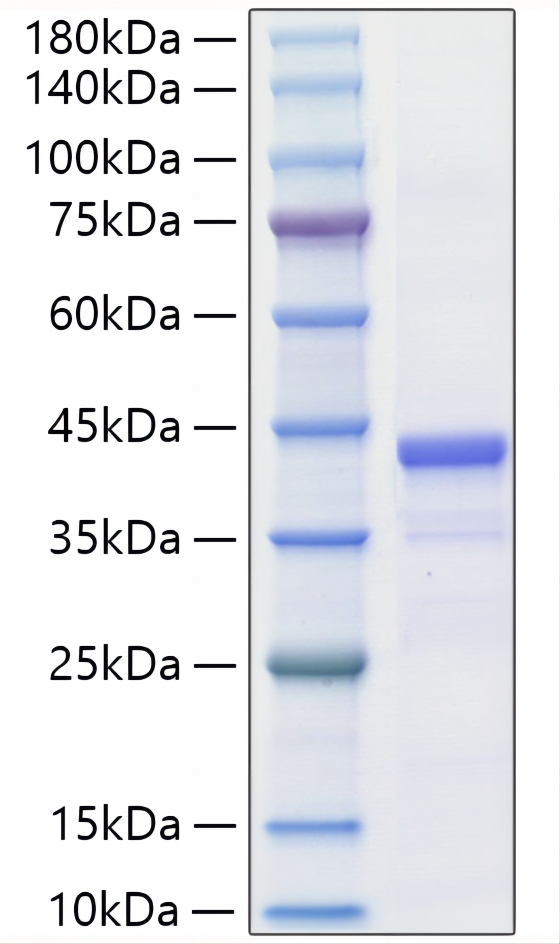Description
Recombinant Mouse IGF-II Protein
The Recombinant Mouse IGF-II Protein is a high-quality recombinant protein designed for murine biological research applications. This protein serves as an essential reagent in mouse model studies, comparative immunology research, and preclinical therapeutic evaluations, enabling scientists to investigate IGF-II biology and its relevance to human disease mechanisms through translational research approaches.
This product (SKU: RPCB1241) is produced using HEK293 cells and features a C-hFc tag for convenient detection and purification. The protein exhibits a calculated molecular weight of 33.35 kDa with an observed molecular weight of 35-45kDa under denaturing conditions, achieving ≥ 95 % as determined by SDS-PAGE., ensuring exceptional quality and consistency for research applications.
Key Features
| High Purity by Affinity Chromatography | |
| Mammalian & Bacterial Expression Systems | |
| High lot-to-lot consistency via strict QC |
| Product Name: | Recombinant Mouse IGF-II Protein |
| SKU: | RPCB1241 |
| Size: | 10 μg , 20 μg , 50 μg , 100 μg |
| Reactivity: | Mouse |
| Synonyms: | C11orf43, chromosome 11 open reading frame 43, FLJ22066, FLJ44734, GRDF, IGF2, IGF-2, IGFII, IGF-II, insulin-like growth factor 2 (somatomedin A), insulin-like growth factor II, insulin-like growth factor type 2, MSA, PEG2, PP9974, somatomedin-A |
| Tag: | C-hFc |
| Expression Host: | HEK293 cells |
| Calculated MW: | 33.35 kDa |
| Observed MW: | 35-45kDa |
| Gene ID: | 16002 |
| Protein Description: | High quality, high purity and low endotoxin recombinant Recombinant Mouse IGF-II Protein (RPCB1241), tested reactivity in HEK293 cells and has been validated in SDS-PAGE.100% guaranteed. |
| Endotoxin: | < 0.1 EU/μg of the protein by LAL method. |
| Purity: | ≥ 95 % as determined by SDS-PAGE. |
| Formulation: | Lyophilized from a 0.22 μm filtered solution of PBS, pH 7.4. |
| Reconstitution: | Centrifuge the vial before opening. Reconstitute to a concentration of 0.1-0.5 mg/mL in sterile distilled water. Avoid vortex or vigorously pipetting the protein. For long term storage, it is recommended to add a carrier protein or stablizer (e.g. 0.1% BSA, 5% HSA, 10% FBS or 5% Trehalose), and aliquot the reconstituted protein solution to minimize free-thaw cycles. |
| Storage: | Store at -20℃.Store the lyophilized protein at -20℃ to -80 ℃ up to 1 year from the date of receipt. After reconstitution, the protein solution is stable at -20℃ for 3 months, at 2-8℃ for up to 1 week. |
IGF-II (Insulin-like growth factor II; also multiplication-stimulating polypeptide/MSP and somatomedin-A) is a secreted 8 kDa polypeptide that belongs to the insulin family of peptide growth factors. It is part of a complex system of growth and metabolic-regulating proteins that is particularly important during development. It has been associated with nervous system proliferation and differentiation, myelination, adrenal cortical proliferation, and skeletal growth and differentiation. In human, IGF-II is primarily synthesized by the liver, and circulates at high levels in both fetus and adult. In rodent, however, IGF-II levels drop after the perinatal period, an effect attributed to the lack of a key gene promoter. This may indicate that postnatally, IGF-II has either a limited, or local effect only in rodent. For example, evidence suggests IGF-II may be the intermediary for SHH induction of VEGF attendant with local neovascularization. Rodent cells known to express IGF-II include astrocytes, hepatocytes, osteoblasts, embryonic striated muscle cells plus Kupffer cells and Ito cells. Mouse IGF-II is synthesized as a 180 amino acid (aa) preproprecursor). It contains a 24 aa signal sequence, a 67 aa mature region, and an 89 aa C-terminal prodomain that is alternatively referred to as the E-peptide. Mature IGF-II is 91% and 97% aa identical to human and rat IGF-II, respectively. Proper processing of IGF-II requires the chaperone activity of GRP94. This generates an 8 kDa mature form, an 18 kDa, 156 aa proform, and a potential 11 kDa, 88 aa “Big” form (aa 25-112). This 11 kDa ”Big” form would be equivalent to human 15-16 kDa IGF-II, with the 5 kDa difference attributable to the presence of O-linked glycosylation. There is an additional 34 aa proteolytic fragment that is termed preptin and contains aa 93-126 of the preproprecursor. This is distinct from IGF-II, is secreted by pancreatic b cells, and facilitates insulin secretion. IGF-II has multiple binding partners. It binds to IGF-IR, the Insulin receptor (IR)-type A and IGF-IR:IR-A hybrids, the type 2 IGF receptor (IGF-2R), and IGF binding proteins 1-6. The first three receptors initiate downstream signaling events, the IGF-2R sequesters local IGF-II, and the six IGFBPs regulate IGF-II activity in various tissues.







